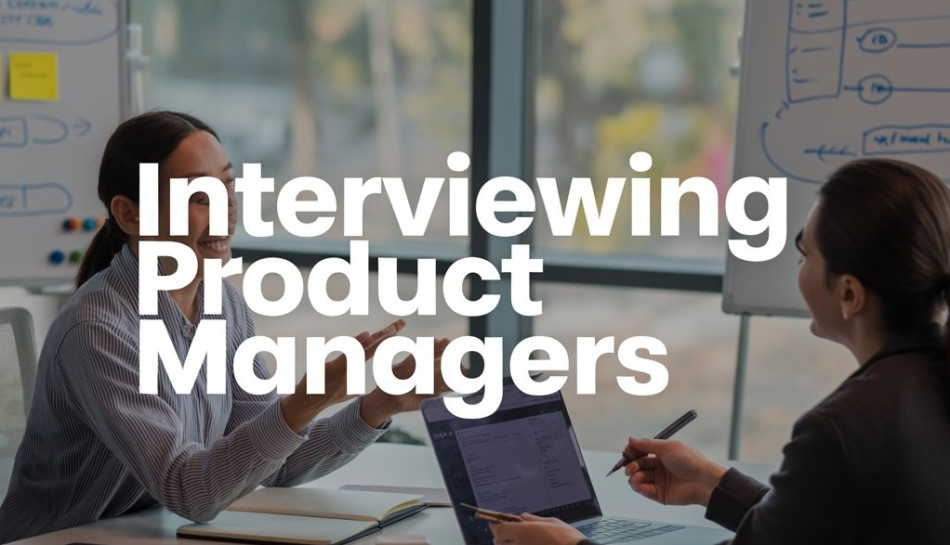Product Management
How to Interview Product Managers
9 Nov 2025

Few people are ever trained in interviewing future hires. You’re handed someone’s resume and tossed into a meeting with the candidate. The hiring manager might tell you what topics they want you to cover.
So you think back to the questions people asked you and ask versions of those. What are your strengths and weaknesses? Tell me about your greatest accomplishment? How do you prioritize?
But these don’t really tell you anything about the candidate. They don’t give you great signal about their relative skill in doing the job. What if their greatest accomplishment has nothing to do with building products? And even if it does, what are you going to learn from them describing it?
When you ask them how they do something, you’ll get an idealized version of what they would do, instead of a realistic description of how they really work.
The best way to improve your questions is to define your intent up front. Identify the traits and skills you’re looking for, and think of a way the candidate can demonstrate that skill in an interview. This usually involves asking them to describe real-world situations that used the skill.
For all your questions, write down what you are trying to learn by asking it. Think through what a strong answer would be and how you’d distinguish from a weak answer.
During the interview, probe their answers to find out what they specifically did. Product managers accomplish almost all their work through the team, so it can be hard to get them to say what they actually did. Getting this is crucial.
To get you started, here are some examples of questions I use in actual product management interviews.
Talk about a time when you needed to make a decision but didn’t have enough data.
- Tests comfort with ambiguity and decision-making frameworks. Strong answers show structured thinking (using proxies or assumptions explicitly stated, setting up ways to validate the decision post-facto) and clarity of reversible decisions rather than paralysis or reckless guessing.
Walk me through a product you shipped with an engineering partner. What was your role versus theirs? How did you divide responsibilities? How often did you talk?
- Tests understanding of PM-eng boundaries and collaboration style. Look for clear frameworks for how they divide up work, evidence of trust-building, and appropriate communication cadence that respects engineering focus time while maintaining alignment.
Give me an example of choosing between technical debt and new features. What was the situation and what drove your decision?
- Tests ability to balance long-term platform health with business pressure. Strong answers demonstrate understanding of compound effects of debt, ability to quantify impact in business terms, and stakeholder management to get buy-in for "invisible" work.
You wake up Monday morning and it’s not obvious what you should work on. How have you handled this in the past?
- Tests agency, self-direction, and strategic thinking. Look for comfort with ambiguity, systematic approaches to prioritization (reviewing OKRs, checking metrics, talking to customers) rather than just picking whatever seems urgent or interesting.
Walk me through entering a new B2B market or customer segment. How did you learn about it? What changed based on what you discovered?
- Tests customer discovery skills and ability to adapt. Strong answers show multiple learning methods (direct customer conversations, industry research, competitive analysis), specific insights gained, and concrete product or GTM changes made based on findings.
Think about a product launch where support, sales, or marketing needed to execute. What did you do to set them up for success?
- Tests cross-functional leadership and internal enablement. Look for proactive preparation (documentation, training, feedback loops), understanding of each team’s needs, and evidence of treating internal teams as important partners.
Your team is getting pulled in multiple directions by competing priorities. What’s your approach to keeping everyone focused on strategy?
- Tests leadership and strategic alignment skills. Look for clear prioritization frameworks, ability to say no with rationale, regular strategy reinforcement, and protecting the team while managing stakeholder expectations.
Walk me through your typical week in terms of working with data and metrics. Give me a recent example of using data to drive a decision.
- Tests analytical rigor and data fluency. Strong answers show regular metric review habits, comfort with different data tools, ability to spot patterns and anomalies, and translating data insights into specific actions.
Pick a metric you owned and moved. What was it, where did it start and end, and what specifically did you do?
- Tests results orientation and attribution clarity. Look for appropriate metric selection for the business goal, understanding of leading/lagging indicators, specific interventions tied to metric movement, and honest assessment of what worked versus luck.
Think about an obstacle that could have killed your product. What was it and how did you get through it?
- Tests resilience and problem-solving under pressure. Strong answers show ability to identify existential risks early, creative solution generation, stakeholder marshaling in crisis, and learning extraction from near-failure experiences.